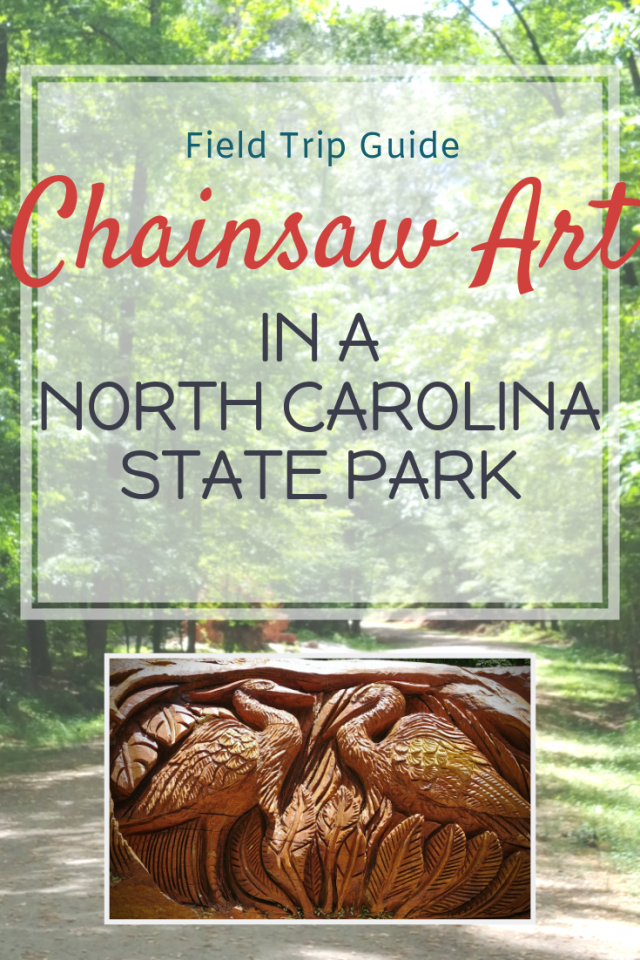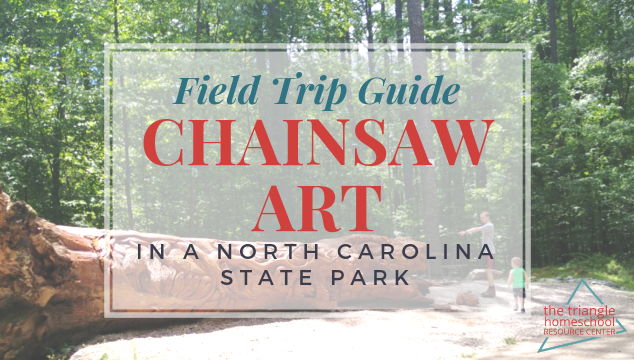Artists use tools of all kinds. But chainsaw art? That’s not a combination topmost in our minds. A trek to find the carved tree in the William B. Umstead State Park might change your mind about that. This field trip is part art study, part nature study, and a whole lot of oohing and aahing!
Chainsaw Art in the Park
In 2015, a storm blew over a massive oak in William B. Umstead State Park. But when the chainsaws came out, they weren’t used to make firewood out of the oak that had been standing in Raleigh for over 100 years. Instead, they transformed the debris into a beautiful work of art.
In this article, I’ll tell you what you need to know to find this unusual sculpture. And I’ll link to resources you can use in your homeschool to learn more about both the art and the nature you’ll encounter on your walk!

The treasure hunt
William B. Umstead State Park (simply known in these parts as ‘Umstead’) is located on the northwest side of Raleigh “between the beltlines” of I-440 and I-540. The Reedy Creek entrance on the south side of the park is located just off of I-40 exit 287. The walk to the log is a little over 3 miles (and then three miles back, of course) from that parking area. Since we have a 3-year-old, and we were short on time, we opted to enter the park from US-70 (Glenwood Avenue) and follow the signs to the Sycamore parking lot.
From the parking lot, it was easy to see the prominent “Trailhead” sign. We picked up a map from the box by the sign and discovered there were two easy-looking routes to the carved tree. We opted to go directly to our destination on the multi-use Graylyn Trail (or M.U.T.). This trail is wide, pretty flat, and gravelly for use by pedestrians, cyclists, and horses. Watch your step, but it would be navigable with a sturdy stroller. Little ones on bikes might have difficulty unless they’re experienced trail riders.
Following Graylyn to the east, we turned right after crossing Sycamore Trail. It was a mere 0.6 miles, but because the tot and teen stopped to have frequent – um – discussions over who was in front, it took us about 20 minutes. (*sigh*… A dump truck could fit down this trail, y’all.) But it was a beautiful breezy day, so the pace allowed us to appreciate the bird calls and other signs of wildlife while the littlest marveled at the occasional jumbo jet flying low overhead on its approach to RDU.
You can’t miss the beautiful work of art lying to the left of the path shortly after crossing the North Turkey Creek trail.
Both of my boys love to watch their dad make quick work of storm debris with his chainsaw, but that is messy work. So they weren’t expecting the beautiful carvings on this massive old trunk. It is truly “chainsaw art”, beautifully preserved, and the picnic table in the clearing is a great spot to stop and have a snack while you admire the details.
The scenic return trek
After a nice stop and lots of pictures, we continued south on the Graylyn Trail and turned right onto the Sycamore Trail. This route is definitely not stroller or bicycle friendly. The trail takes you up a gentle slope. There are a lot of roots and rocks and the path is much narrower. But it is was a beautiful walk through the woods. When Sycamore Trail splits, stay to the right and continue until you can make a left back onto Graylyn Trail. It made our complete walk just under two miles, so it was a really nice way to spend a peaceful afternoon.
Resources
If you have been following this site or the Facebook page for any length of time, you know how I love my field trips! After all, what is a field trip but a chance to experience learning out in the world?
(Don’t miss the Beginner’s Guide to Homeschool Field Trips!)
On this kind of excursion, you can let the learning happen organically! My 15-year-old is much more knowledgeable about the outdoors than I am, so he educated me on moss growth (no, it’s not just on the north side of things), trail markings, and map reading. We encouraged the 3-year-old to think about what animals live in the forest. He happily informed us that horses resided among the trees and to prove it, he pointed out every trail sign bearing horse and rider. Touché. He also said he was on the lookout for sneaky foxes, happy bats, and friendly owls. I love the sweetness of that age, don’t you?
If you want to plant seeds ahead of time, perhaps that organic learning might be more fruitful. Or you can see what the kids take away from the walk and branch out from there.
Ok, enough with the corny nature references. Without further ado, here are some resources that might help you satisfy curiosity and extend the learning!
Chainsaws and art
- A News & Observer article gives good background information about the chainsaw art in Umstead
- Carving was done by artists Jerry Reid, of Smoky Mountain Art, and Randi Boni.
- This VisitRaleigh article has multiple suggestions for other routes to the fallen tree.
- A page on The Pro Cutter gives information about the history of the artform, as well as equipment used and other resources for research. But my favorite part of this article are the incredible pictures!
- Many other kinds of art can be made from wood, including some beautiful vessels by an artist named Mike Hughes. What other kinds of wooden art can your kids research?
- What is the outlook for careers in woodworking?
- Are there any other local examples of chainsaw art? Have you ever seen any elsewhere?
William B. Umstead State Park
- Learn more about the history and ecology of William B. Umstead State Park.
- Check out the Exhibit Hall while you visit, and extend your visit by timing it to coincide with one of the many events and programs available.
- Visit the North Carolina History Project’s site to learn more about W.B. Umstead.
Nature Study
(Obviously, this not an exhaustive list. There are a lot of good general nature study resources, and Charlotte Mason inspired ideas. I’ll try to keep this list brief and particular to this field trip, but the first few are must-haves on my shelves for anything outdoors!)
- North American Wildlife Guide
- Fun With Nature Take Along Guide and other guides in this series
- Web article about Identifying Oak trees in North Carolina
- North Carolina Trees and Wildflowers Pocket Guide (These laminated pamphlets are great, and the gifts shops at the NCMNS and NCMH have some that I haven’t been able to find on Amazon or anywhere else.)
- A unit study on Horses (so your preschooler doesn’t continue to drag you into the woods looking for them)
- Tremendous Trees unit study
- Try a unit study on a season and make the walk part of that!
- Montessori-inspired oak tree life cycle from Welcome to Mommyhood
- List of books about acorns from Homeschool Preschool
- How to Identify Trees from ThoughtCo.
- Wildlife info from the NC Wildlife Resources Commission
Related art projects that don’t involve chainsaws
- Zentangle leaf art from The Crafty Classroom
- The art and science of leaf rubbings from Edventures with Kids
- Woodworking projects for kids from How Wee Learn
And all the rest
- Bring that park map home and let your preschooler have fun (read more at Picklebums)
- Acorn math busy bag for kids from Toddler Approved
- Calculate the calories you burned on your walk.
- Volunteer opportunities and Junior Rangers at the North Carolina State Parks



